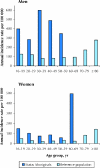Epidemiology of severe trauma among status Aboriginal Canadians: a population-based study
- PMID: 15824405
- PMCID: PMC556038
- DOI: 10.1503/cmaj.1040432
Epidemiology of severe trauma among status Aboriginal Canadians: a population-based study
Abstract
Background: Aboriginal Canadians are considered to be at increased risk of major trauma. However, population-based studies characterizing the distribution, determinants and outcomes of major trauma in this group are lacking. We sought to measure the impact of ethnicity, as reflected by Aboriginal status, on the incidence of severe trauma and to broadly define the epidemiologic characteristics of severe trauma among status Aboriginal Canadians in a large health region.
Methods: This population-based, observational study involves all adults (people > or = 16 years) resident in the Calgary Health Region between Apr. 1, 1999, and Mar. 31, 2002. Stratification of the population into status Aboriginal Canadians and the reference population was performed by Alberta Health and Wellness using an alternate premium arrangement field within the personal health care number. Injury incidence was determined by identifying all injuries with severity scores of 12 or greater in the Alberta Trauma Registry, regional corporate data and the Office of the Medical Examiner.
Results: Aboriginal Canadians were at much higher risk than the reference population in the Calgary Health Region of sustaining severe trauma (257.2 v. 68.8 per 100,000; relative risk [RR] 3.7, 95% confidence interval [CI] 3.0-4.6). Aboriginal Canadians were found to be at significantly increased risk of injuries resulting from motor vehicle crashes (RR 4.8, 95% CI 3.5-6.5), assault (RR 11.1, 95% CI 6.2-18.6) and traumatic suicide (RR 3.1, 95% CI 1.4-6.1). A trend toward higher median injury severity scores was observed among Aboriginal Canadians (21 v. 18, p = 0.09). Although the case-fatality rate among Aboriginal Canadians was less than half that in the reference population (14/93 [15%] v. 531/1686 [31%], p < 0.0001), population mortality was almost 2 times greater (RR = 1.8, 95% CI 1.0-3.0, p = 0.046).
Interpretation: Severe trauma disproportionately affects Aboriginal Canadians.
Figures


Comment in
-
Getting to the root of trauma in Canada's Aboriginal population.CMAJ. 2005 Apr 12;172(8):1023-4. doi: 10.1503/cmaj.050304. CMAJ. 2005. PMID: 15824407 Free PMC article. No abstract available.
References
-
- Canadian Institute for Health Information. National trauma registry report: Hospital injury admissions 1998/1999. Toronto: The Institute; 2001.
-
- Facts on injury. Public Health Agency of Canada. Injury section. Available: www.phac-aspc.gc.ca/injury-bles/facts_e.html (accessed 2005 Feb 28).
-
- Government of Canada. Indian Act. Ottawa: The Government of Canada; 1996. cat. No. YX76-I5/1996.
Publication types
MeSH terms
LinkOut - more resources
Full Text Sources
Medical
Miscellaneous
